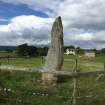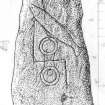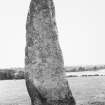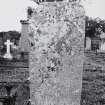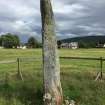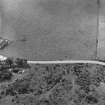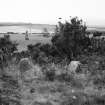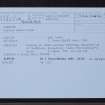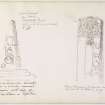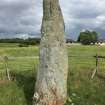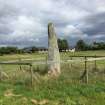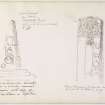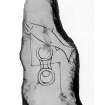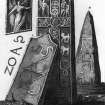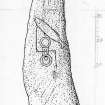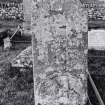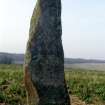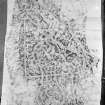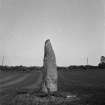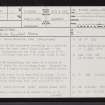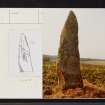Following the launch of trove.scot in February 2025 we are now planning the retiral of some of our webservices. Canmore will be switched off on 24th June 2025. Information about the closure can be found on the HES website: Retiral of HES web services | Historic Environment Scotland
Clach Chairidh, Edderton
Pictish Symbol Stone (Pictish), Standing Stone (Prehistoric)
Site Name Clach Chairidh, Edderton
Classification Pictish Symbol Stone (Pictish), Standing Stone (Prehistoric)
Alternative Name(s) Clach Biorach; Ardmore Lodge Hotel; Edderton Inn; Cariblair; Carriblair; Balblair
Canmore ID 14653
Site Number NH78NW 2
NGR NH 70833 85074
Datum OSGB36 - NGR
Permalink http://canmore.org.uk/site/14653
- Council Highland
- Parish Edderton
- Former Region Highland
- Former District Ross And Cromarty
- Former County Ross And Cromarty
Edderton 1 , Clach Chairidh, Ross & Cromarty, Pictish symbol stone
Measurements: H 3.13m, W at base 1.07m, D at base 0.46m
Stone type: red sandstone
Place of discovery: NH 7082 8507
Present location: in situ in a field.
Evidence for discovery: first recorded (inaccurately) by Cordiner in 1780.
Present condition: weathered.
Description
This pointed pillar stone is likely to have been a prehistoric standing stone, an outlier for the nearby stone circle, which has been re-used as a Pictish symbol stone. Incised on its north face are two symbols, a salmon above a double disc and Z-rod set vertically. Cordiner shows a circle below on the left, which is no longer visible but could have been part of a mirror.
Date: seventh century.
References: Cordiner 1780, 119; ECMS pt 3, 57-9; Fraser 2008, no 121.
Compiled by A Ritchie 2017
NH78NW 2 7082 8507
(NH 7083 8506) Clach Chairidh (NR) (Sculptured)
OS 6" map, Ross-shire, 2nd ed., (1907).
According to the Rev. Charles Cordiner the stone stood 'on a circular mount, artificially raised with steps of earth, at Cariblair in Ross-shire.'
C Cordiner 1788.
An unhewn pillar of red sandstone narrowing to a point at the top - whence the local name 'Clach Biorach' - 'the sharp stone'. Sculptured on one side only, it is 10ft 3ins high by 3ft 6ins wide and 1ft 6ins thick at the base (Allen and Anderson 1903).
There is a circle surrounding the stone at a radius of 3 yards, and 2ft above the surrounding plain. Supposed to mark the grave of a Danish prince killed in nearby battle.
New Statistical Account (NSA, written by D Gordon - 1840) 1845; J R Allen and J Anderson 1903.
This large symbol stone is as described by Allen and Anderson (1903).
It is oriented NW-SE but there is no trace of a circle round it. Gordon (NSA 1845) is probably confusing this site with NH78NW 1.
Visited by OS (W D J) 17 May 1963.
(NH 7083 8506) Clach Chairidh (NAT) Symbol Stone (NR)
OS 1:10,000 map, (1973)
This symbol stone, standing in an arable field, is as described by the previous authorities. Its position is erroneous on the OS map; it stands at NH 7082 8507, some 15m to the N. It has not been moved.
Surveyed at 1:2500.
Visited by OS (J B) 27 February 1973.
This Class I symbol stone bears the fish symbol over a double-disc and Z-rod.
J R Allen and J Anderson 1903
Class I symbol stone bearing a salmon above a double-disc and Z-rod.
A Mack 1997.
Field Visit (9 September 1943)
This site was included within the RCAHMS Emergency Survey (1942-3), an unpublished rescue project. Site descriptions, organised by county, vary from short notes to lengthy and full descriptions and are available to view online with contemporary sketches and photographs. The original typescripts, manuscripts, notebooks and photographs can also be consulted in the RCAHMS Search Room.
Information from RCAHMS (GFG) 10 December 2014.
Aerial Photography (1969)
Oblique aerial photographs of Clach Chairidh Pictish symbol stone, Ederton and the site of Carriblair stone circle, photographed by John Dewar in 1969.
Field Visit (November 1977)
Clach Chairidh, Edderton NH 708 850 NH78NW 2
A Class I 'Pictish' symbol stone decorated with a fish and double disc and Z-rod symbols.
RCAHMS 1979, visited November 1977
(Allen and Anderson 1903, iii, 57-9)
Publication Account (1995)
A tall pillar-like stone some 3m high, this can be approached closely when there is no crop. There are two symbols, a fish cut obliquely at the top, and below this the double-disc and Z-rod, set vertically to fit onto the narrow stone. The carving is worn, and best seen in a sideways light in the early orning. Only two of the fish's fins can now be made out. Other marks on the stone a re the result of weathering and of parts of the surface having flaked off. It is probable that this tall pillar, an unusual shape and size for a symbol stone, is a bronze-age standing stone to which the symbols were added some 2,000 years later. There are several other known or suspected instances of Pictish symbols added to prehistoric stones.
Almost directly opposite th e standing stone, in the gorse bushes on the other side of the road and close to the fence, is part of a rough circle of low boulders, probably the kerb stones of a bronze-age cairn now robbed away. Within the circle is a cist grave or stone coffin which has been dug out.
Information from ‘Exploring Scotland’s Heritage: The Highlands’, (1995).
External Reference (2 November 2011)
Scheduled as 'Clach Chairidh, symbol stone... a standing stone, decorated with Pictish symbols, situated on a natural eminence in a pasture fielsd on the N edge of Edderton village. The stone stands within a small fenced enclosure approximately 135m SSW of the Ardmore Lodge Hotel (also known as the Edderon Inn). The standing stone itself was erected probably in the Neolithic or Bronze Age period... [and] was re-used probably some time between 500 AD and 700 AD when Pictish symbols were carved on it.'
Information from Historic Scotland, scheduling document dated 2 November 2011.

































